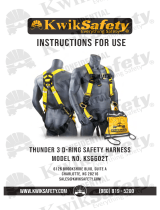
PN110361-03 ©2018 Werner Co. Rev C 4/18
Werner Co. Fall Protection
93 Werner Rd. Greenville, PA 16125
724-588-2000 • 888-523-3371 toll free • 888-456-8458 fax
LABELS
WARNING
Compliant fall protection equipment
must only be used as it was designed.
Users MUST read and follow all user
instructions provided with the product.
1
2
3
4
5
6
7
8
9
10
11
12
Inspection Log/Registro de Inspección
Year
Año 1Year
Año 2Year
Año 3Year
Año 4Year
Año 5
User:
MALL
A
PP
E
L
E
ADVERTENCIA
Equipo anticaídas conformes debe
utilizarse sólo como fue diseñado. Los
usuarios deben leer y seguir todas las
instrucciones de usuario suministradas
con el producto.
P/N110358-01 Rev A 9/16
ANSI Z359.11-2014
ANSI Z359 Recognizes the use of this
harness only within the capacity range of:
130-310 lbs.
Weight capacity (OSHA): up to 400 lbs.
A- Back D-Ring
E- Shoulder D-Ring
L- Chest D-Ring
P- Hip D-Ring
Misuse or failure to heed these
warning and instructions may result
in injury or even death
Capacidad de peso (OSHA): hasta 400 libras.
El uso incorrecto o no tener en
cuenta estas advertencias e
instrucciones podria resultar en
lesiones o incluso la muerte.
PEQUEÑO
Labels
Etiquetas
93 Werner Road, Greenville, PA 16125
1-888-523-3371
© 2016 Werner Co.
P/N 110767-01 Rev A 9/16
Standards/Estándares
ANSI Z359.11-2014
OSHA 29 CFR 1910.66 and 1926.503
Serial Number:
Número de serie:
Model / Modelo:
Assembled in:
Ensamblas en:
Mark Number/Número de Mark de 1
UPC
WARNING
Before using a fall arrest system, users
must be trained in the safe use of the
system, as required by OSHA 29 CFR
1910.66 and 1926.503, or local safety
regulations. Product must be inspected
prior to each use according to the user
instructions, and additionally by a
competent person who is not the user, at
intervals of no more than one year.
Only make compatible connections. User
repairs and alterations are NOT permitted.
Avoid physical and enviromental hazards
such as thermal, exposure to sharp edges
and abrasive surfaces, machinery, and
eletrical and chemicals sources. For
proper use see supervisor, user
instructions, or contact Werner Co.
This harness is equipped with Gravity
Override. In the event of a Fall, simply
grab the patented Relief Cord handles
and pull out and forward, while lifting
legs to a seated position. See user
instructions manual for more
information.
Only back D-rings (A) is to be used for
fall arrest. Hip D-rings (P) are for
work positioning only. Chest D-rings
(L) is for attachment to climbing
system or retrieval only (2 feet
maximum free fall). Shoulder D-rings
(E) are for retrieval only.
ADVERTENCIA
Antes de usar un sistema de detención de
caída, los usuarios deben ser entrenados
en el uso seguro del sytem, como requerido
por OSHA 29 CFR 1910.66 y 1926.503, o
normas de seguridad locales. El producto
debe ser inspeccionado antes de cada uso
según las instrucciones de usuario, y
además por una persona competente que
no es el usuario, a intervalos de no más
que un año.
Sólo haga connectins compatible. El usuario
repara y las modificaciones no son
permitidas. Evite físico y riesgos de
enviromental como termal, exposición a
bordes agudos y superficies abrasivas,
maquinaria, y fuentes de productos
químicos y eletrical. Ya que uso apropiado
ven a supervisor, instrucciones de usuario,
o se ponen en contacto con el Werner Co.
Estas guarniciones son equipadas con
la Gravedad Anulan. En caso de una
Caída, simplemente agarre los mangos
de Cuerda de Alivio patentados y
saque y expida, levantando piernas a
un posición asentado. Ver el
manual de instrucciones del usuario
para obtener más información.
D-anillos sólo traseros (A) para ser
usado para detención de caída. Los
D-anillos de cadera (P) son para el
trabajo que coloca sólo. Los D-anillos
de pecho (L) son para el accesorio a
sistema trepador o recuperación sólo
(caída libre máxima de 2 pies). Los
D-anillos de hombro (E) son para la
recuperación sólo.
© 2016 Werner Co.
P/N 110768-01 Rev A 9/16
Labels
H0








